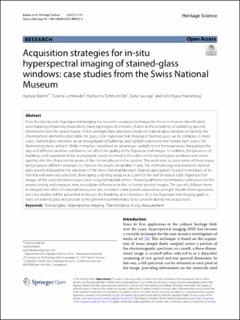| dc.contributor.author | Babini, Agnese | |
| dc.contributor.author | Lombardo, Tiziana | |
| dc.contributor.author | Schmidt-Ott, Katharina | |
| dc.contributor.author | George, Sony | |
| dc.contributor.author | Hardeberg, Jon Yngve | |
| dc.date.accessioned | 2023-11-24T13:08:24Z | |
| dc.date.available | 2023-11-24T13:08:24Z | |
| dc.date.created | 2023-05-15T11:27:46Z | |
| dc.date.issued | 2023 | |
| dc.identifier.citation | Heritage Science. 2023, 11 (1), . | en_US |
| dc.identifier.issn | 2050-7445 | |
| dc.identifier.uri | https://hdl.handle.net/11250/3104569 | |
| dc.description.abstract | Over the last decade, hyperspectral imaging has become a popular technique for the non-invasive identification and mapping of painting materials in many typologies of artworks, thanks to the possibility of obtaining spectral information over the spatial region. A few attempts have also been made on stained-glass windows to identify the chromophore elements responsible for glass color. Hyperspectral imaging of stained glass can be complex; in most cases, stained-glass windows are an integral part of buildings, and sunlight represents the natural light source for illuminating these artifacts. While it may be considered an advantage, sunlight is not homogeneous throughout the day, and different weather conditions can affect the quality of the hyperspectral images. In addition, the presence of buildings and vegetation in the background could also modify the colors of the stained-glass windows and consequently alter the characteristic peaks of the chromophores in the spectra. This work aims to solve some of these issues and proposes different strategies to improve the results obtainable in situ. The methodology was tested on stained-glass panels displayed in the windows of the Swiss National Museum. Stained-glass panels located in windows of an internal wall were also analyzed, developing a lighting setup to account for the lack of natural light. Hyperspectral images of the selected stained glass were acquired multiple times, choosing different transmittance references for the preprocessing and exposure time to evaluate differences in the collected spectral images. The use of a diffuser sheet to mitigate the effect of external factors was also tested on some panels exposed to sunlight. Results from representative case studies will be presented to discuss the feasibility and limitations of in-situ hyperspectral imaging applications on stained glass and provide some general recommendations to consider during the acquisitions. | en_US |
| dc.language.iso | eng | en_US |
| dc.publisher | Springer | en_US |
| dc.rights | Navngivelse 4.0 Internasjonal | * |
| dc.rights.uri | http://creativecommons.org/licenses/by/4.0/deed.no | * |
| dc.title | Acquisition strategies for in-situ hyperspectral imaging of stained-glass windows: case studies from the Swiss National Museum | en_US |
| dc.title.alternative | Acquisition strategies for in-situ hyperspectral imaging of stained-glass windows: case studies from the Swiss National Museum | en_US |
| dc.type | Peer reviewed | en_US |
| dc.type | Journal article | en_US |
| dc.description.version | publishedVersion | en_US |
| dc.source.pagenumber | 0 | en_US |
| dc.source.volume | 11 | en_US |
| dc.source.journal | Heritage Science | en_US |
| dc.source.issue | 1 | en_US |
| dc.identifier.doi | 10.1186/s40494-023-00923-6 | |
| dc.identifier.cristin | 2147517 | |
| cristin.ispublished | true | |
| cristin.fulltext | original | |
| cristin.qualitycode | 2 | |

